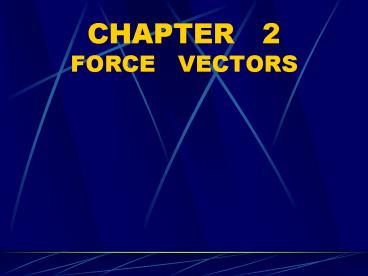CHAPTER 2 FORCE VECTORS PowerPoint PPT Presentation
Title: CHAPTER 2 FORCE VECTORS
1
CHAPTER 2 FORCE VECTORS
2
2.1 Scalars and Vector
1.Scalar A quantity characterized by a
positive or negative number.
Length Volume Mass
symbol L V M
EX
2.Vector A quantity having both a
magnitude and a direction.
EX position, force, moment Symbol
or A
line of action
magnitudeA
direction degree c.c.w
sense arrowhead
3
2.2 Vector operation
1.Scalar Multiplication and Division
2.Vector Addition
Parallelogram Law
4
3.Vector Subtraction
4.Resolution of Vector
(1) Known (2) Two line of action are known.
5
2.3 Vector Addition of Force
1. Engineering problems
(a) Find the resultant force, knowing its
components.
resultant force ??
(b) Resolve a known force into two components.
6
2. Analysis method
agt Parallelogram law bgt Trigonometry
igt sine law iigt cosine law
7
2.4 Addition of a System of Coplanar Forces
1. Rectangular components
2. Notation (1) scalar notation
Algebraic scalars are used to express the
magnitude and directional sense of the
rectangular components of a force.
8
- (2) Cartesian Vector Notation
- Cartesian unit vector i and j are used to
express the directions of x and y axes
respectively . The magnitude of each component of
force F is always a positive quantity.
9
- 3. Coplanar Force Resultants
(1) Resolve each force into it x and y components
using Cartesian vector notation.
10
- (2) Add the respective components using
scalar algebra
(3) Form the resultant force by adding the
resultant of the x and y components using the
parallelogram law.
magnitude
orientation
11
2.5 Cartesian Vectors
1. Right-Hand Coordinates system
2. Rectangular components of a vector
12
- 3. Unit vector
- A vector having a magnitude of 1 .
a vector, unit vector of ??
Unit vector (dimensionless)
4. Cartesian unit vectors i , j ,k .
Cartesian unit vector i ,j ,k are used to
designate the direction of the x, y, z axes
respectively.
13
- 5. Cartesian vector representation
unit vector of
unit vector of
unit vector of
14
(1) Magnitude of Cartesian vector A
(2) Direction of Cartesian vector A The
orientation of A is defined by the coordinate
direction angles a ß ?
Direction consines cosaAx/A cosßAy/A
cos?Az/A
Direction of A is defined by its unit of vector uA
15
2. Subtraction A-B RA-B(Ax-By)i(Ax-By)j
(Az-Bz)k
2-6 Operations of cartesian vectors
- AdditonAB
- AAxiAyjAzk BBxiByjBzk RAB(AxBx)i(Ay
By)j (AzBz)k
3. Concurrent Force System
are algebraic sums of the
respective x,y,z components of each force in the
system .
16
2-7 Position Vectors
- 1. Definition
- A position vector is a fixed vector which
- locates a point in space relative to another
point. - 2. Position vector from origin 0 to point P(x,y,z)
Cartesian vector form of r
3. Position vector from point A to point B
17
2-8 Force Vector Directed Along A Line
u Unit vector defines the direction and sense of
position vector r and force vector F.
18
2-9 Dot Product (Scalar Product)
1. Definition
A.BABcos? ,0lt?lt180
2. Law of operation
- (1) A.BB.A
- (2) a(A.B)(aA.B)(A.aB)a(A.B)
- (3) A(BD)A.BA.D
19
3. Cartesian vector formulation (1) Dot
product of Cartesian unit vector i .
i11cos0?1 j . j1 , k . k1 i .
j11cos90?0 , i . kk . j0 (2) Dot product
of vectors AB in Cartesian vector form
AAxiAyjAjk BBxiByiBjk
A.B(AxiAyjAjk).(BxiByiBjk)
AxBxAyByAzBz
20
4. Applications (1) Angle between two vectors
?
(2) Components of a vector parallel and
perpendicular to a line.
A
?
A known vector ? angle b/w A and u. u unit
vector of a line (known)

